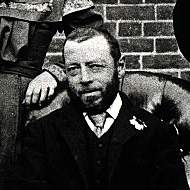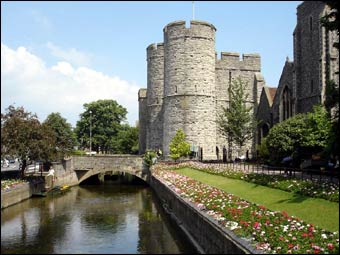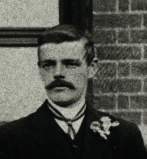
![{$text['mgr_brown1']}](../tng_placebrown.jpg) Eldridge 5
Eldridge 5
My early years: personal memories of Kent
by Winifred Mary Eldridge
Introduced by Richard Eldridge
Introduction
My mother was born in the early part of the twentieth century. One of three sisters and a brother they grew up in the depths of the Kentish countryside in the quiet years prior to the second world war. Never to be one who stayed at home, Mum started work by being a companion to a young boy who was convalescing from illness and this lead to her career in nursing.
Mum is now 93 years old , and although in a nursing home , she still fondly remembers those early years in Kent. She has written down some of her memories from that time which are now recounted.
Chapter 1: Canterbury

Winifred Eldridge
I was born on May 5th 1912, in Ashford, Kent either at Croft Road or Linden Road. My father, William Curtis, was dark haired and very good looking. He had five brothers (Tom, Steven, Harry, Jack and Arthur) and five sisters (Ellen, Elizabeth, Sarah, Maria and Alice). Many of the family worked at the Kings School, Canterbury. My grandmother worked in the kitchens and later Elizabeth, her daughter, was trained as a cook and worked there. My Uncle Harry was for many years the Bursar there and his sons went to the Kings School, one as a chorister going on later to a very rewarding life in music. These were my parents first homes, but I remember very little of being in Ashford. My first firm memories are of when we moved to Canterbury in 1917.
When the war broke out in 1914 lots of my relatives went to the war. My uncle joined the Flying Corp. Later he was reported missing and that was all my aunt ever heard. She had two daughters to bring up.
My father (William Curtis) had decided to join up but by now it was 1917 and he had four children so we moved to Canterbury while he was away to be near my father’s mother and father. My grandparents were very kind to us. My grandfather (Thomas Curtis) was in charge of the large coal yard in Stour Street, Canterbury and lived in the house attached to it. This was a most interesting place. To us it was a very large area with different kinds of coal heaped up in different piles. The horses, there were about six, each had a large stable. We used to go and talk to each one and pat them and give them sugar. One stable held the horse who was ill - we were always told to keep away from this one in case he was cross. This was called the loose box. As you can imagine there were many other sheds and storage places . Great fun for a lot of children to play in and later, when war came, bicycles and tricycles were stored there while their owners were away.
I did not realise that my grandmother (Jane Manooch) was very strong on hoping that we all went to church and Sunday School. We went to St. Alphage Church [FOOTNOTE A] and to Sunday School in a church room near by. In my class I had a girl who had been burnt. Her face was always covered in cream. That used to bother me a bit.

The Huguenot organ


Thomas Curtis, Jane Manooch (1)
My grandmother was descended from the French Huguenots and had a strong feeling for the church. Their history was persecution for their Protestantism and they had fought to keep their church. They were given the use of part of the crypt of Canterbury Cathedral. There is a small door on the south side of the cathedral. My grandmother was a strong influence on all our lives and she encouraged us to go to Sunday School regularly. She was a very loveable person who treated all her grandchildren (she had 27) with great kindness and real love. On Sundays after we had been to Sunday School we all used to go and see her and were rewarded with one currant fancy cake and one tart – these always tasted better than anything we ate throughout the rest of the week. Afterwards we went out into the coal yard to play. My father had left a tricycle in the loft of my grandfathers buildings and one of the older ones used to ride it round the loft with about six other children on various parts of the frame. Then we changed over and the others had a ride until my grandmother called out to say “time for you all to go home”.
When I went with my mother to the mothers’ meeting my Gran made everything fun. When they had a cup of tea we had biscuits to eat. She was a lovely person, having had 12 children (3 died while small). So was my grandfather – a very kind man. He was a good looking man with an iron grey Van Dyke beard and did not chat readily. He was rather remote, hardly doing more that say hello to us. He was ill with a bad heart for years. He died suddenly in his sleep one Sunday morning aged about 50 and although his sons were all grown up they all cried when he died. In 1922 no resuscitation or intensive care unites existed.
Page added - February 18th 2006
Last updated - April 19th 2012
I was 2 years old when the 1914-1918 war broke out. We were living in Ashford then. I do not remember my father joining up to go to war but after that we moved to Canterbury to No. 4 Hawks Lane, an old weather boarded house, now pulled down. We lived a very happy life in this cottage - one in a terrace of three with no back way. It consisted of a parlour, a dining room and kitchen downstairs and two bedrooms and an attic upstairs. My mother, father and younger sister shared one bedroom, my elder sister and I shared the other bedroom and my brother had the attic. It was a palace and we were happy.

Zeppelin (2)

Westgate (3)
At 5 years I can remember going to school for the first time. Our cousins lived in a house not far from the school and I had a great friend in one of my cousins. I was often round at their house playing, I did not like leaving and was always in trouble for staying and playing with them instead of going home for my meals.

William Curtis (1)
I do not remember much about the war except when an air raid siren went and we ran home as fast as we could. During this time Zeppelins used to fly over Canterbury and the only way we knew a raid was likely to happen was a red flag put on top of Westgate Towers. One day when this occurred I was on my way home for tea and a woman said “Don’t you know the red flag is up on the towers? Run home like blazes !” The only time I had heard that word was to do with fires so I did run home. At the bottom of our street was a factory where people were doing war work making armaments. We used to watch the girls come out with yellow faces due to the chemicals they worked with.
After this my Gran had to leave the coal yard and went to live at No. 2 Iron Bar Lane Canterbury [FOOTNOTE B]. In the Second World War this house had a direct hit with a bomb but my Gran had died by then.
When my father joined up in 1917 he went in to the army and went to France as a lorry driver. I can remember my mother saving up scraps of meat etc for when my father came home on leave. On one occasion, his leave was deferred and the meat went bad before he came home. My father’s leaves were very exciting but when he left early in the morning to go back to France we were all very sad and as we walked home from my grandmother’s the night before, my father would sing ”We’ll all cling together like the ivy on the old garden wall”. He used to take supplies and ammunition from the base camp up to the fighting area. This was quite dangerous and he had many narrow escapes as when air raids occurred they used to get out of the lorry and lie in a nearby ditch but the only injuries he had resulted in a small scar on his nose. As with many men from that war he did not say a great deal about his experiences.
{William Curtis' war diary can be found at The Western Front 1916: A World War I Journal - RE}
Footnotes
[A] St Alphege: Archbishop and "the First Martyr of Canterbury."(7) He was born in 953 and became a monk in Gloucester, England. In 984 Alphege was made bishop of Winchester. In 1005 he was installed as the archbishop of Canterbury but was captured by the Danes pillaging the southern regions. The Danes besieged Canterbury and took Alphege captive. He refused a ransom demand and was hit with an axe and beaten to death. His body was moved to Canterbury in 1023. His emblem is an axe, and he is depicted in his pontifical vestments or as a shepherd defending his flock.
The church is now used as the Canterbury Environment Centre.
[B] Iron Bar Lane: Although severely damaged by bombing in World War II, the area has been rebuilt and redeveloped. Interestingly for a family renowned as feline fanciers, No 1 Iron Bar Lane is currently occupied by an establishment with the quaint title "Nothing But The Cat" (6)
References
1. Curtis Family Photographs: The Family History of Alexander Curtis at LogicMill
2. A World War I Zeppelin: Wikipedia
3. The Westgate, Canterbury: BBC On Line
4. St Alphege Church, Canterbury: Church Bells of Kent
5. Iron Bar Lane, Canterbury: The Canterbury Tour
6. Nothing But The Cat, Canterbury: © Webshots.com © aroundengland
7. St Alphege: Catholic On Line: Saints and Angels
Please contact us
 If you have any questions or comments about the information on this site in general, or you have further information regarding this article, please Get in touch by leaving a message in our Guestbook. If you don't want the message to be added to the Guestbook, just say that in your text. We look forward to hearing from you.
If you have any questions or comments about the information on this site in general, or you have further information regarding this article, please Get in touch by leaving a message in our Guestbook. If you don't want the message to be added to the Guestbook, just say that in your text. We look forward to hearing from you.
Return to Top of Page
Translate this page:
Internet Beacon Diamond Site - 2010
© The Craxford Family Genealogy Magazine and individual copyright holders.Edited and maintained by Alan D. Craxford 2005 - 2024. All rights reserved. Contents may not be reproduced without permission.
You are not authorized to add this page or any images from this page to Ancestry.com (or its subsidiaries) or other fee-paying sites without our express permission and then, if given, only by including our copyright and a URL link to the web site.




















